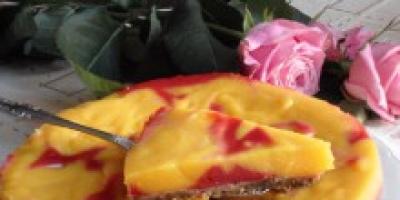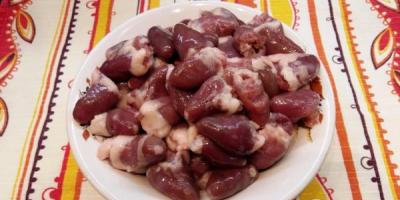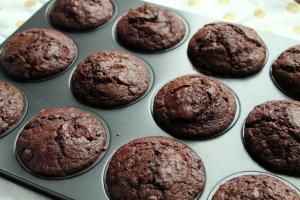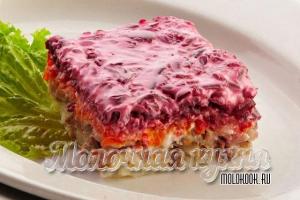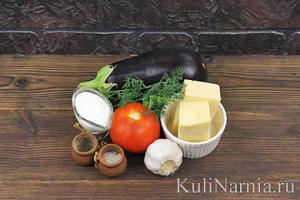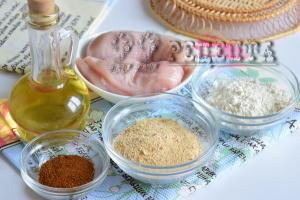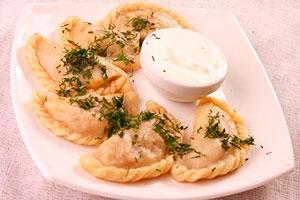27,220 views
Bread - simplest product, which requires only a few ingredients to prepare: flour, water and yeast. But it’s worth adding a couple of additional components, changing the shape or resting time of the dough, and you’ll get a great variety of options for your favorite baked goods.
So in Italy, each region can boast of its own variety. flour product. Since 1998, the republic has legislation regulating the production and trade of the popular product. We present to your attention all types of Italian traditional breads, arranged according to their native regions.
Homemade Aquilano bread (Pane Casareccio Aquilano) has a typical wrinkled shape with a bright golden crust, 3-4 mm thick. The fresh bun is crispy with the flavor of corn toast, although the composition mainly contains wheat flour.

Another representative of the region's baked goods is Parruozzo. The main ingredient in its composition is corn flour. Before preparing the dough, it is brewed with boiling water and left to rest overnight. The bread has a dark crust and a rich corn flavor. On Italian tables it often accompanies vegetable dishes.
Apulia

Altamura bread (Pane di Altamura) is produced in all corners. Its high quality is confirmed. It is prepared from wheat flour premium quality, water, yeast, salt and malt. Wheat durum varieties rich in gluten, which makes the product especially healthy. Altamura is baked in a wood or stone oven. The crust of the bread is very crispy, and the crumb is airy and light yellow in color. The loaf is round in shape with one or two cuts in the top.

Taralli is a typical Apulian pastry. This is a non-yeast product, which includes: flour, water, salt, olive oil and dry white wine. Pieces of prepared dough are rolled into tubes and then closed into a ring. Cooking consists of two stages. At the first stage, Taralli is boiled, at the second stage, it is dried in an oven until golden brown. In appearance they resemble domestic bagels, but in Italy they are consumed as bread during meals.

Friselle are bagels made with durum wheat flour. They're not just baked, they're baked twice. The finished buns are cut in half lengthwise and baked again. As a result, Friselle has a compact, dry structure. Before use, soak it in cold water until desired softness. Usually sprinkled with garlic, tomatoes, oregano or watered olive oil.
Basilicata

Matera bread (Pane di Matera) is a product produced using an ancient baking system. The dough with semolina and durum wheat flour is baked in wood-burning ovens. It is awarded the IGP quality mark. It is shaped like a crescent. Loaf weight 1-2 kg. The crumb is light, the aroma is rich. Matera refers to products long-term storage(7-9 days).

Ruccul is this, but of earlier origin. It consists of standard bread dough flavored with garlic, oil, oregano and chili pepper. The entire manufacturing process is done manually. Just like its close relative, Rukkul is baked in the form of flatbread.. Its surface is usually uneven and golden brown in color.
Valle d'Aosta

The typical bread of the region is called Pan Ner or Black. It is prepared from rye flour. It has a hard, thin crust and a compact structure. It is often flavored with cumin or fennel seeds. Today, there are still bakeries in the region that make Pan Ner in old-style ovens.
Veneto
Bovolo bread is traditionally baked here. It stands out among its peers due to its unusual spiral shape.. It consists of soft flour, water, salt, yeast and beer. The ripened dough is divided into small pieces and twisted into a spiral. The result is small golden-colored buns weighing no more than 150 g.
Cioppa or Cioppetta is a typical bread of the province. It is also surprising for its cross shape. Depending on the bakery, they make it with either longer or more rounded sides. It consists of flour, water, several types of yeast and salt. The finished product has a compact structure and a crispy crust. Most often, a loaf of Choppa is cut into individual buns and used for sandwiches.

(Ciabatta) - the most famous for domestic consumers italian bread. The peculiarity of the product is the large amount of liquid in the composition (70% of the total mass of flour). It is easily recognized by its dark crust and highly porous crumb. The taste is delicate, slightly salty.
Calabria
Pitta bread, made from flour, water, salt and yeast, can easily be confused with Armenian lavash. It is round, flat and soft. This type of baking is typical for Middle Eastern countries. Pitta usually not only accompanies main dishes, but is also used with sauces as a snack.

Campaign
Peasant bread (Pane Cafone) is typical of the region, but is common throughout Italy. The peculiarity of its preparation is that it contains a mixture of wheat and semolina. This combination makes the taste of the product refined and rich. Its crust is dark, crispy (a little hard). Although Kafone originated as a poor man's food, today it is considered one of the best breads of the republic.

Pagnotta di Santa Chiara is more like a pie than bread. They bake it from flour, mashed potatoes, yeast, lard and pepper. The finished product is garnished with anchovies and tomatoes, and sprinkled with oregano and parsley.
Lazio

The main hero of bread houses can undoubtedly be called Genzano's Homemade Bread (Pane Casareccio di Genzano). This product has the IGP Protected Geographical Indication. It is prepared from flour, yeast, salt, water and wheat bran. The weight of the loaves ranges from 0.5 to 2.5 kg. The crust is dark in color interspersed with bran. The aroma of Genzano bread is described as the smell of fresh grain. The taste is pleasant with a slight sourness.
Liguria

It is famous for its Focaccia Genovese. The flatbread is made from wheat flour, olive oil, salt, water and yeast. This a real delicacy, which can be eaten both early in the morning for breakfast and late in the evening as a late-night snack. At dinner she is accompanied by a small glass of white wine. There are many options for adding classic bread. For example, focaccia with white onions is very popular. It is finely chopped and added to the dough. The traditional one is serving flatbread sprinkled with olives or sage. Modern versions include fillings of meat, tomatoes, cheese, nuts or raisins (in a sweet version).

One more thing signature dish Ligurian cuisine - Ciappe flatbread. Their name literally translates as “flat stone.” The composition includes flour, water, oil and salt. Ready dough roll out only a few millimeters thick and 10-15 cm in diameter. Like focaccia, chiappe can be supplemented with onions or spices. Crispy bread with your favorite accompaniment - great option light breakfast.
Lombardy

Michetta is a type of bread widespread in (especially in). It is easily recognized by its typical star shape. To prepare it, flour is mixed with water, malt and yeast. The dough matures for at least 16 hours. In the end it has “perfect” elasticity. Due to its delicate texture, Miquette is widely used for making sandwiches, but tends to lose its crispness within a few hours of cooking.
Mantovano is a typical pastry from the province. This is one of the most ancient types of bread in Lombardy cuisine. It includes several types: Baule and Ricciolona. The second version is supplemented with butter and lard. Traditionally it is made from flour, water and sourdough. The finished product is characterized by a dry texture. Mantovano has the shape of a loaf with ridges formed due to transverse cuts in the dough. The size is usually not large: from 30 to 250 g.
Marche

Crescia bread is produced throughout the region in various options. So, in the Montefeltro area it is known as Spianata, and in Pesaro - Crescia Brusca. Seasoned with herbs and cracklings, the product is called Pizza coi grasselli or “Pizza with herbs.” Traditionally, Kresha is topped with butter, rosemary and onions. In some provinces it is grilled. The product has a flat, round shape about 2 cm high. In appearance, it resembles a pizza base. Often used as a base for many fillings.

Crostoli del Montefeltro is prepared in Pesaro. This bread looks like a thin flatbread. The color of the crust is usually light golden. It is often eaten with sausages, cheeses, meats and grilled vegetables.
Molise

As in Molise, they bake their own cornbread called Parozzo Molisano. Unlike its neighbor, it also contains wheat flour and boiled potatoes. The dough is prepared for 2 days, after which it is baked over high heat.

Scarpelle is one of the most unusual breads in Italy. Although its composition is quite ordinary (flour, water, salt and yeast), it is made not by the usual baking, but by frying in olive oil. The result is irregularly shaped bread cylinders with a golden-colored crust.
Piedmont

A bread called Grissino is the star. It consists of thin sticks ranging from 20 to 80 cm in length. To prepare it, wheat flour, water, milk, yeast and salt are used. To obtain more delicate and fragile options, a little oil is included in the composition. After resting, the dough is rolled out by hand and baked for 15-20 minutes. The result of this work is the unsurpassed crispness of Grissini.

Biova Piemontese is another type of bread traditional for the region. It consists of flour, yeast water and salt. It has an oval shape. Biova is often baked in the form of small buns for making a variety of sandwiches, including sweet ones.
Sardinia

Carasau is a typical Sardinian bread whose second name sounds like carta da musica (musical paper). It characterizes its incredible crunchiness, which creates a rather “musical” noise when chewing. The product is made from durum wheat flour, water, yeast and salt. It is used in two ways. Dry Karasau accompanies both salty and sweet dishes. Pre-soaked in water - it serves as the basis for various fillings: meat, cheeses, vegetables.
Sicily

Pagnotta del Dittaino, like many DOP breads, is made from premium flour, as well as water, yeast and salt. The loaves are usually medium in size (1-1.4 kg), round in shape with a thick skin and a yellow crumb. The product can be stored for no more than 5 days.

Mafalda is a bread made from flour, semolina, malt, sesame seeds, yeast and salt. Its shape resembles a sleeping snake sprinkled with sesame seeds. The dough is rolled into a cylinder and folded in a zigzag with 4 loops, the remaining end is placed on top along the length. In Palermo bakeries it is the most common type of pastry.
Trentino-Alto Adige

The bread made from is called Chifel. Its shape is identical to a croissant, which confuses uninformed buyers. In fact, it contains no sugar, only flour, water, oil, yeast and salt. The result is a small bun weighing 30 g with a shiny thin crust. Its taste is delicate with a slight saltiness. Kiefel is great for making both sweet and savory breakfast sandwiches.
Tuscany

Tuscan bread (Pane Toscano) became famous for its “tasteless” taste due to the complete absence of salt. It has a rectangular, ovoid or round shape and a golden crust. It is often used to make croutons by cutting it into slices and frying it in the oven. In 2016, salt-free bread received the DOP quality category.

The entire Maremma region produces Pagnotta Maremmana, a product made from wheat flour, water, starter and brewer's yeast, and salt. The loaves are round, the color of the crust depends on the type of flour (from light to dark golden).
Friuli Venezia Giulia

Biga bread, the literal translation of which sounds like “chariot,” is widespread in. To prepare it, flour, water and yeast are mixed in such a ratio that the finished product is quite dry. It has a semicircular shape with a small crack at the top.

In the province of Udine it is impossible to miss the traditional Grispolenta. These are a kind of rustic breadsticks 15 cm long and thick as a thumb. It contains corn and wheat flour, water, olive oil, lard, sourdough and salt. Corn flour gives the finished product a delicate aroma and friability.

Typical of the colder months in the area is Pan de Frizze bread. It is made from wheat flour, eggs, cracklings, lard, salt and yeast. Visually, it resembles a flatbread with filling. This product is especially popular in peasant areas.
Umbria

Terni bread (Pane di Terni) is produced throughout the territory. It is made from wheat flour, water, salt and several types of yeast. The loaves are oval or round in shape and weigh about 800 g. Terni is known for its reputation for "homemade bread".

Pan Caciato is a cheese bread that is a legacy of the classic Italian cuisine. In addition to flour, yeast and water, it contains: olive oil, Pecorino cheese, walnuts and raisins. Once matured, the dough is cut into 650g pieces, left to rise and baked in a preheated oven. Pan Caciato with cheese aroma endowed with notes of sweet wort due to the presence of raisins in it.
Emilia-Romagna

The most famous bakery product, undoubtedly, can be called Piadina Romagnola IGP. It is prepared from wheat flour, water and salt. Knead the dough with your hands and roll it out with a rolling pin until you get a disk of the desired size. Some options include adding a little oil or lard to the composition. The dough is baked on stone slabs. The finished bread has the shape of a flat cake with a diameter of 15 to 30 cm and a thickness of 3 to 8 mm. Piadina accompanied by ham or sausage is a common street snack method.

The province of Modena is famous for its Tigella Modenese, made from flour, water and salt. The peculiarity of this bread is that it is baked in special molds that imprint a beautiful pattern on it. The buns are small in size (diameter 15 cm, thickness 1.5 cm). In many taverns, Tigella is included in the menu as a second course.

Ferrarese spears (Coppia Ferrarese) – bread from the province (Ferrara). Its name literally translates as “couple”. It is due to the shape of the product, which resembles two ropes connected to each other. For its high quality, the product was awarded the IGP category in 2004. It contains: flour, lard, olive oil, sourdough, salt and malt. The weight of the finished bread ranges from 80-250 g. The crispy crust and tender center make the Spear an excellent “tool” for collecting sauces from the plate during lunch.
Having traveled through all regions of the republic, our review has come to an end. Italian bread is not just baked goods. This is the most ingenious way to win the heart of a tourist once and for all.
↘️🇮🇹 USEFUL ARTICLES AND SITES 🇮🇹↙️ SHARE WITH YOUR FRIENDS
There are a lot of varieties of Italian bread, like coffee. Until recently, I called everything in one word “ pane" If there was no bread on the table in a restaurant, I asked the waiter: “ Un pane, per favore!“They brought me something floury and I was glad about it. Moreover, the bread they served was always different: round, square, with pimples, etc. After two years I learned to distinguish it. Let's figure out together what is hidden behind the commonly used word “bread” in Italy.

Un panino These are small buns that are a must-have attribute of continental breakfasts all over the world. They are easy to heat up and break apart conveniently. If you cut this bun in half and spread it with cheese, it will be un panino al formaggio(un panino al formaggio), and if we put in Parma ham, we get un panino al prosciutto(un panino al prosciutto).

La Pagnotta– does it resemble our bun or loaf? It ranks second in distribution after panino.

Il filone- the older brother of the French baguette. Thicker and more well-fed.
Lo sfilatino/La Frusta

Lo sfilatino/La frusta- The little brother of the French baguette. Originally from the village. Shorter, but of the same build. It got its name from the parallel cuts along the rind, in which the Italians of the Renaissance saw a small enfilade. Compare.

What an amazing feeling of beauty, isn't it? And here in Russia everything falls under one word - bun.

La Crescente- this is what they call the young moon on profit. This huge bread fully lives up to its name. Usually diameter Crescente is approximately 40 cm and weighs more than 1 kg.

La ciabatta- a rectangular bread that looks like a worn-out shoe (hence the name). The outside of the ciabatta is covered with a hard, crispy crust, and inside there is very soft, porous bread. When you eat real Italian ciabatta, you experience an orgasm. When there is no orgasm, you have been deceived and given something else, as often happens in Russian public catering.

La Tartaruga- a round bun with a crust baked on top like a turtle shell (hence the name).

La Rosetta- small rose. For those who don't like turtles.
And finally...

Il Grissino – breadstick. It was invented in 1679 for Victor Amadeus II (Duke of Savoy), who as a child had some disagreements in his personal life with bread crumbs. The boy's father was very worried that his son did not eat bread. On the advice of the doctor, the court cook baked bread that did not crumble. Since then grissini(plural) are very popular throughout Italy.
Bon appetit!
Teresa wonderfully shows how strong the starter should be for this baking - in her second photo you can see how mature the starter should reach in three hours. It perfectly shows how flowing, light, and perfectly kneaded the dough should be at the end of kneading.
I kept admiring these photos, and then I decided to bake it myself. To be honest, I was a little afraid - the relatively small amount of flour in this recipe relied on a huge amount of yolks. I had never baked something like this before, but I was very interested in the fact that with the huge number of yolks, the dough was reminiscent of the richest and most complex baba from Elena Molokhovets, the kind about which she says: “they don’t always work out, but when they do, they are wonderfully tasty.”
I made this cake the first time and everyone immediately liked it. The taste and texture are not easy to describe - I've never eaten anything like it before. It turns out clearly confectionery, with an incredibly weightless crumb that melts in your mouth. This is completely different from the usual baked goods. It seems that the dough loses its materiality, breadiness, moving into another taste category, a little reminiscent of the lightest creamy foam. The crumb is lacy, light, with large pores.
()
- April 14th, 2012 , 01:37 pm
A few years agoago I was invited to work in the north of Italy. I could fly to Verona or Venice. Lived in Venicemya friend is an artist, and he suggested that I come at least two days earlier. He himself is a “native” Venetian, that is, he belongs to a very small number of people who were born and lived their entire lives in Venice. And his wife is from a very old and famous family in Venice. Silvestro promised to show me not the tourist Venice, but the Venice of the Venetians.
I was able to come and, thanks to Silvestro and his family, I spent two completely unforgettable days in this incredible, amazing city. I remember the first morning very clearly: we entered a house with a completely forgettable facade, walked along a long corridor and suddenly found ourselves in a wonderful, small garden. The back wall was covered with roses. Our table was under a huge rose bush with a complex apricot-coral color. We sat down at the table and the back facade of the house appeared before our eyes: unlike the one facing the street, this one was very beautiful. It was a garden not open to everyone, and beauty hidden, not boastful; beauty is only for your own people.
The waitress brought coffee and pastries unfamiliar to me, light, beautiful yellow. This was the Venetian Easter Bread, Fugasse, as it is called in the Venetian dialect (in Italian it should be called focaccia).
Once upon a time, fougasse was a holiday bread in general.
()
- April 11th, 2012 , 11:30 am
This is a wonderfully tasty thing. Voluptuous, as one of my Italian tasters said. I made these panettones last year along with a more traditional panettone from a famous Italian pastry chef. But it was this panettone from Adriano that earned the highest praise from my Italian company. And it was precisely this that there was not a piece left by the end of dinner. The marzipan melts a little during baking and a tender, moist cave is formed, and chocolate drops on the contrary, they smell like chocolate inclusions in the most delicate, aromatic pastry.
Recipe from the "tinker" series. But for the sake of such a result, no amount of work is spared.
The original recipe was published by Adriano on his wonderful blog Profumo di Lievito, . My comments or clarifications are written in blue. Yes, by the way, Adriano suggests making marzipan yourself, but, of course, you can just buy it, and there will be less work.
()
- March 31st, 2012 , 01:38 am
I don’t have time to write a detailed article yet, but several people have already asked me about the Italian wheat sourdough that I use. Unfortunately, I don’t have the opportunity to write a long article yet - I have neither time, nor peace of mind, nor concentration. Therefore, I will simply show you a place where this is very well and in detail described: on my favorite gennarino forum.
This can be translated with Google, but for now I’ll just point out the main points. At one time I was going to write an article about sourdough, so I have some photos.
For Italian sourdough, use strong white flour. Since neither whole grain nor rye is added at all, and the amount of enzymes in white is significantly lower, they add, to speed up fermentation, overripe fruit with skin, crushed into a puree (there are usually a lot of enzymes on the skin). In theory this is not necessary. You can simply mix flour with water and wait for it to sour. But I read from an Italian author that before, in Italian village kitchens they stored a lot of fruits and vegetables, some of which were overripe, and there were no modern means of washing surfaces - they washed simply with soap, and not with our lethally sterile preparations. In our kitchens there is simply a much more sterile atmosphere, there is much less live yeast, live enzymes, so it is better to use fruit.
When the flour has fermented, flour is added again and fed, as always, in a certain sequence and rhythm. Finally, the leaven begins to form. Then they do some things with it that are unusual for other starters.
()
- March 26th, 2012 , 01:29 am
Not forever Lent, Easter will come soon. And with it will come festive food and Easter cake baking. Let me put here recipes for Easter cakes that I especially love.
Not long ago, at Rozik's prompting rozik1965
, I bought a book about Easter cakes. I’ll tell you about the book in a separate post, but now I’ll say that I love baking Easter cakes and bake a lot every year (I give them away): I don’t forget old recipes, and I try new ones.
As I understand it, there are two types of Easter cakes - dense and airy, and there are people who are accustomed to one or the other type. Last year I baked Easter cakes for my friends. One of them, Lena, called me and said: “It’s very tasty, we ate it in one sitting. But it’s too airy, it looks like panettone, but not like Easter cake.” And behind her, her second friend called, Marina: “Oh, Olechka, how good your little bean is! Mom and I ate, and my mother, like me, thinks it’s a real Easter cake, like our grandmother baked.”
Here I will put a selection of three recipes. Since I myself am a lover of airy cakes, two recipes are dedicated specifically to them, and the third is dedicated to dense, cake-like cakes. I don't like this one too much yeast baked goods, but I love this cake. Its taste makes up for everything: it has an amazingly rich, festive taste.
Two recipes are my reconstruction of ancient Easter cakes, and the third is my reconstruction of Italian Easter bread - Colomba. Unlike many other colomba recipes, this one can be baked in the form of a cake and holds up well in a tall shape. In the photo, the cake is baked using this very dough. It is very large (20 cm high) and heavy, more than 2 kg. All of these recipes were popular at Cooking. ru. A lot of people have made them, and if you follow the links and scroll ahead, you can find a lot of reviews. Publication of Russian Easter cakes, publication of Colomba Easter cake. I set recipes without changing them.
()
- March 21st, 2012 , 08:06 pm
It's wonderfully tasty and delicious recipe Adriano. Original recipe in Profumo di Lievito. At the same time, this is one of two of his recipes that I baked several times, and I became convinced that I did not get them right: I did not get such a fluffy cake as in the original photo. In the end, I decided that I simply had a different torment, and nothing could be done about it. Or maybe I was wrong and it’s not the flour that should be blamed, but the hands. But it’s okay, it’s not scary. Failures, especially such tasty ones, are a good incentive to continue learning.
But I also make it so delicious... not even a pie, but a real yeast cake that it’s worth posting the recipe. Maybe other people can do it better than me. I wish you do better than me. There will be someone to learn from.
This is my old translation, I installed it on cooking.
The unusual thing about this recipe is that lemon puree is added to the dough. It's important to do this correctly, as Adriano explains, otherwise the acid will damage the gluten and the dough will tear.
()
- March 18th, 2012 , 12:49 am
Pan baba
This is one of my favorite recipes from Adriano. I often bake this “bread baba” and almost always before the road. And on the way, I take it out and am again amazed at the aroma of this muffin - it smells absolutely breathtaking. And I rejoice in its tenderness, its lightness, its lacy airiness. And all this consoles and pacifies me, because I love to travel, but I don’t like physical travel itself, airports, train stations, airplanes, I’m always nervous and always worried.
Adrienone puts neither raisins, nor chocolate, nor candied citrus peel into this pastry, so as not to weigh down its almost downy lightness - it is simply weightless as a cloud. Adriano's original recipe
He bakes it as a loaf, and as soon as I baked it - both as a loaf in a round shape, and in a beautiful spiral shape, and in the form of molded individual buns with raisins and without raisins (without raisins is still better), which you can simply take with you . Baking in a mold is a must for this baking. Without a mold, the dough will settle and become heavy.
Yes, here’s another thing: the amount of oil can be reduced a little. I reduced it to 90 grams, and it didn’t really affect the taste, though. Of course, the more oil, the better the baked goods are stored.
()
- February 20th, 2012 , 11:28 pm
This is also a translation of an old recipe that I used in cooking. The photo is very bad, I will replace it later. And the bun is delicious. This time, in addition to the cream and cherries, I added a little ground almonds - I really like the almond-cherry combination.
In the south of Italy, not far from Naples, on the shores of the Mediterranean Sea there is the city of Aversa. Aversa is famous for its glorious historical past - a thousand years ago battles raged there, diplomatic dispatches flew, a big game was going on between the Normans, Byzantium and the papacy. But all this is long gone, and today Aversa is famous for its wonderful pastry filled with custard and cherries. It is called la Polacca, la gran Polacca, sometimes la Polaccona.
They say that the very idea of combining lush butter dough, custard and cherries, was born thanks to a Polish nun who, in the thirties, shared a recipe for the pie (hence the “Polish” name for the pastry). Other versions name the author as a local confectioner, who in 1939 began offering his clients “Polish cake” (torta polacca), as this pastry is sometimes called. Brioche quickly became popular, even very popular. Now they make it both large (in the form of, say, a pie or a crown) and portioned. Individual brioche are wrapped like a bagel or just a ball - as in the book of the famous Italian pastry chef Massari.
(
Hello, dear readers. In this article I will try to answer in detail the question - “What is Italian bread and what is it eaten with?” And also, if you read it to the end, you will find out what herbs Italians like to add to bread and what bread they think is the most delicious.
Concept italian bread very vague since each Italian region has its own traditions and its own recipe for making bread. Each of them honors and keeps their secrets and technologies for producing the most delicious bread, in their opinion. There are simply a huge variety of recipes, and the ingredients are impossible to imagine in a traditional recipe.
Included may include corn flour, as well as barley, soy and potato, I generally keep quiet about seasonings (dill seeds, cumin, marjoram, mint, coriander, chamomile, rosemary), as well as products such as chestnuts, olives and peppers, I even recently came across.
There are also a lot of baking methods. Some simply mix all the ingredients together, others add sourdough prepared the night before to the dough, and the bread acquires a strong aroma and is stored for several days.
There are a lot of regions in Italy, so there are also a lot of cooking technologies. Italians, who love their country very much and are proud of it, say that in preparing Italian bread you shouldn’t rely too much on the ingredients alone; they believe that a special role is played by climate of the country, water and even air, strange as it may sound. The climatic conditions of the region in which the wheat was grown are especially important.
In Italy, as you know, it is very warm, which is probably why Italian bread is so delicious. Or maybe because only durum wheat is used to make Italian bread.
Where it was baked also matters a lot. The most delicious Italian bread comes from a real wood fired oven. In this case, the oven is heated to a temperature of 350-400 degrees Celsius and only after that, after three to four hours, the oven is considered suitable for baking.
Every Italian baker has his own secrets and Tips for making the most delicious Italian bread.
Here are some basic tips to follow when baking:
- for kneading you need a large and smooth work surface
- To prevent the dough from sticking, sprinkle with flour
- the room should be warm and draft-free
- the correct dough for Italian bread should double in size
- the oven must be well heated
- After baking, it is placed on a special grid so that the crust is not covered with fumes and remains hard.
The most delicious Italian bread
Bread with herbs
The birthplace of this Italian bread is considered to be the city of Carrara, which is located in. Currently, there is a lot of experimentation with its composition in Italy and in addition to flour you can also find in it such components as chamomile, mint, lemon balm, nettle, chili pepper, coriander, hawthorn, dill seeds, parsley, rosemary, oregano. Due to its specific tastes, it is usually formed weighing no more than 250 grams. Agree, very original and unique product, and most importantly, as the Italians say, it’s easily digestible.
Altamura bread (Pane di Altamura)

Almatura bread is the only one in Italy whose quality is protected by the European DOP organization. This means that if you bought and ate it, you can be sure that the flour from which it was made was grown only in Puglia and baked only here and nowhere else.
A huge amount of it is exported to European countries. And this is not strange because its shelf life is approximately 10 days. Due to my inexperience, after arriving in Italy I always tried to catch a freshly baked one, but now I understand that you need to travel 400 kilometers to get a freshly baked one.
Altopascio bread
Very delicious bread whose homeland is the “bread town” of Altopascio in the Tuscany region. It contains: wheat flour, yeast and water. No salt, mind you! It is given a different appearance, but mainly the shape of a parallelepiped. The crust of real Altopascio Bread should be golden and crispy.
In mid-May, a bread festival takes place here during which local bakers share their recipes for baking the most delicious bread. There is also the opportunity to taste local wines with local cheeses and cured sausages.
Bread Cafone

This Italian bread can confidently be attributed to the Campania region, and in particular, whose residents say that the recipe for such bread could only come from heaven. The literal translation is “peasant bread.” It contains only flour, yeast, water and salt. Despite the simplicity of the ingredients, it is very tasty.
The shape of the Cafone can vary, but the most common is round. There are also slightly different names depending on the shape, for example they call it long (Cocchia), wide oval (palatone), small 500 grams (palatella). Cafone's weight is usually 1 kilogram.
Carasau bread

The birthplace of this bread is. But to be honest, it’s hard to call this flatbread bread. Well, the composition seems to be correct: wheat flour, semolina, yeast and water. But the baking technology differs significantly from traditional bread. The finished dough is rolled out or stretched into thin circles and baked for several minutes in an oven heated with wood at a temperature of 450°-500°.
Particular skill is to correctly remove it from the oven without damaging it and to prevent the edges from curling. Carasau should be very thin and crispy, hence another name for it: Cartamusica (literal translation: “paper music”).
Chianocco bread
Chianocco is a town in the Piedmont region where the idea to bake this bread was born. It consists of wheat flour, water, yeast, salt, and olive oil or fat. Thanks to the cooking technology, its shelf life is quite long. And the taste is sour due to the long fermentation of the starter (almost a whole day).
The shape of the bread may vary. Weight 600-700 grams.
Homemade bread from Genzano (Pane casareccio di Genzano)

Genzano di Roma is a city in the Lazio region and this homemade bread exactly from there. It consists of: wheat flour, yeast, water, salt and bran, which are sprinkled on top. Proper homemade Genzano bread should have white flesh and a dark brown crust. The shape of this bread is either round or elongated.
Padula bread
Padula bread is also named after the city in which it was produced. It contains: wheat flour, semolina, yeast, olive oil, salt and water. Like Kianokko, it is prepared according to a special recipe, which includes sourdough, thanks to which it can be stored for about two weeks.
The usual shape for it is round with two longitudinal slits at the top.
Bread Ferrara

Ferrara bread is another unusual Italian bread, or rather its shape is not the same as what we are used to, it is made in the shape of a starfish or a spider (it has four “legs”). The ingredients that make it up are: wheat flour, yeast, malt, salt, olive oil and a little sugar.
Piadina Romagnola

This is another type of flatbread that is the creation and pride of the region. But its popularity is so great that you can find it in any corner of Italy. The composition of piadina includes: wheat flour, water, salt, olive oil or fat. After the dough is ready, place the flatbread on a hot surface (preferably stone) and bake.
Unlike the Carasau bread that I mentioned above, the piadina should not be crispy, on the contrary, it should be very elastic so that any filling can be wrapped in it.
Sicilian Mafalda

Mafalda is considered a product; its composition includes flour, malt, semolina (semola), sesame seeds (sprinkled on mafalda), yeast, and salt. The shape of the Sicilian Mafalda can be varied. The most common is when the dough is pulled into a flagellum and shaped like a snake.
And of course, this is not all Italian bread, I did not talk about focaccia, pancare, ciabatta, rosetta and many other types of bread, but I will write about them in one of the following articles.
For people looking for good recipe bread, and those who want to learn how to bake delicious bread from whole flour, I advise you to watch this video:
Even at home, you can prepare baked goods that will meet the highest standards. For example, several recipes for Italian rolls will help decorate any table. It is best to prepare them according to recipes that have been tested both by time and by other chefs.
Italian Panini buns
List of ingredients:
- Flour - 750 grams.
- Water - 300 milliliters.
- Milk - 150 milliliters.
- Olive oil - 5 tablespoons.
- Salt - a teaspoon.
- Fresh yeast - 35 grams.
Cooking recipe
Italian Panini buns are most often baked for closed sandwiches. The simplest recipe for making them is ham between two halves of a cut bun. The variety of “Panini” directly depends on the assortment of your refrigerator and taste preferences. Closed sandwiches may include several fillings at the same time. The advantage of Italian Panini buns is their ease of preparation. Soft inside and covered with a crispy crust, they are perfect for breakfast.
To prepare Italian buns, you need to strictly follow the proportions indicated in the recipe. And the first thing that needs to be heated is milk. Then pour it warm into a bowl. After this, put fresh yeast in the milk and give it ten minutes to bloom. Stir and sift the flour into the mixture, add water and olive oil, and add salt. Knead elastic dough. To prevent the dough for yeast buns from drying out, it must be covered with a towel.
Forming buns and baking
Next, it is best to place the container with the thick mass in a warm room for an hour and a half and let it double in size. Then sprinkle the surface onto which the risen dough will be transferred generously with flour. Then divide it into parts that need to be rolled out into long ropes. Then fold it in half and roll the two halves together. Grease the baking sheet thoroughly with olive oil and sprinkle with wheat flour.

Place all the Italian Panini rolls prepared according to the recipe on it and cover with a towel on top. Leave the baked goods to rise again for sixty minutes. Turn on the oven so that it warms up to two hundred degrees. After an hour, sprinkle all the buns with wheat flour and bake them for fifteen minutes. To make the baked goods more golden brown, you can grease them with butter before putting them in the oven. Using a simple recipe for buns in the oven, you can get tender homemade cakes, ideal for making sandwiches.
Buns prepared with creamy filling
List of products for the test:
- Flour - 450 grams.
- Butter - 80 grams.
- Pressed yeast - 15 grams.
- Milk - 170 grams.
- Sugar - 80 grams.
- Salt - 3 pinches.
- Water - 80 grams.
- Vanilla - 1 sachet.
List of products for filling:
- Cream (33% fat) - 600 grams.
- Sugar - 2 cups.
- Powdered sugar - 1/3 cup.
Cooking according to recipe

To make Italian bread rolls creamy filling, you need to heat the mixed milk and water in a saucepan. Pour the liquid into a bowl and drop the yeast into it. Wait for them to dissolve. Sift premium flour into the mixture. Start the process of kneading the dough and gradually add heavily softened butter to it. At the end of kneading, add a little salt. After kneading for a long time, the dough should be smooth, soft enough and not stick to the bowl and hands. Shape it into a ball and cover with a napkin or towel.
For fermentation, the container with the dough must be kept warm for about sixty minutes. The volume of the kneaded mass will gradually double. After this, it must be kneaded a little and divided into twenty equal parts. Then shape each piece into a ball. Place them on greased baking sheets to proof and leave in a warm room for another sixty minutes. Each ball will double in size again.
Baking buns

Turn on and preheat the oven to 175 degrees. After an hour, place the baking sheets in the oven and bake for fifteen minutes. It is very important not to overcook them, as the inside should remain tender. This time should be spent preparing the creamy filling. Pour the heavy cream into the bowl and beat it with a mixer, gradually adding sugar and vanilla. Remove the baked buns from the oven and wait until they cool slightly. You should not let them cool completely, as you will not be able to fill them with filling later.
The filling is injected into warm buns using a syringe. You need to make a puncture in the center of the bottom and fill the inside of the bun with creamy filling. Place all the stuffed buns on the wire rack with the pierced bottom facing up. Place in the refrigerator for twenty minutes to allow the filling to thicken. Then place the Italian rolls with creamy filling on a plate and sprinkle them with powdered sugar. After which tender and delicious pastries can be served with tea.

Fragrant buns with Parmesan cheese
Ingredients:
- Eggs - 2 pieces.
- Flour - 4 cups.
- Olive oil - 2 tablespoons.
- Sugar - a tablespoon.
- Garlic - 4 cloves.
- Salt - dessert spoon.
- Ground pepper- 1/4 teaspoon.
- Water - 2 glasses.
- Butter - 5 tablespoons.
- Parsley - 0.5 bunch.
- Dry yeast - 2 sachets.
- Parmesan cheese - 300 grams.
Making cheese buns
This pastry is perfect as a complement to main dishes prepared for lunch or dinner. Fragrant and savory buns do not linger on the table. A simple recipe for buns in the oven will help everyone who wants to master another type of baking. They turn out juicy and tender, with a crispy crust, so they will not take the last place on your menu.

First you need to prepare the dough. Pour two glasses of heated water into a bowl, add dry yeast and a glass of sifted flour. Stir the mixture well with a whisk, cover the top with film, and place the dough in a warm place for twenty minutes. When it starts to bubble and grows a little, beat the eggs into it, add salt and olive oil. Mix everything thoroughly with a whisk and gradually, in minimal portions, adding flour, begin kneading. After adding all the sifted wheat flour, finish kneading the dough. It will turn out quite sticky.
Cover the bowl again, but with a towel, and place the dough in a warm place for an hour and a half, where it should grow significantly. After this, pour a couple of handfuls of wheat flour onto a clean table and turn the bowl over so that the thick mass can fall out of it. Lightly knead the dough with gentle movements and begin to form a sheet out of it with your hands. Then take a rolling pin and gently, without pressing too hard, roll out the dough into a rectangle. The thickness of the layer should not exceed one centimeter.

Next you need to completely melt butter and squeeze the peeled garlic cloves into it through a press. Mix and brush the mixture onto the dough. The next layer is Parmesan cheese in the amount of two hundred grams. It needs to be rubbed through a grater with medium mesh and distributed on top throughout the dough. You also need to sprinkle this layer with black pepper and salt. Another ingredient in the filling of Italian buns is parsley. Initially, rinse it, shake it well so that as little water remains as possible, chop it and scatter it on top of the cheese layer.
Then gently press down the long edge on one side along its entire length with your finger. Take a little water into a cup and use a silicone brush to lubricate the pressed edge. Start rolling the opposite side into a roll. At the end, having reached the greased edge, turn the roll several times to glue it. The preparation of the dish is finished. Now you need to take a very sharp knife and slowly cut it into pieces. The width of the roll should not exceed four centimeters.

Place parchment paper on the bottom of the baking sheet and grease it with olive oil. Place future Italian buns with cheese on it. If the cut edges do not stick somewhere, be sure to press them down or pinch them. The top of the baked goods should be greased with olive oil. Top each bun with remaining shaved Parmesan cheese. Keep them warm for twenty minutes. After proofing, place the pan in the oven for twenty minutes. The baking temperature should be 200 degrees. After cooking, let the buns sit for at least ten minutes and you can enjoy this Italian pastry.
Delicious homemade buns are a great addition to any meal. In addition italian pastries doesn't have to be sweet. Therefore, it can be either an addition to the main course or a dessert.
